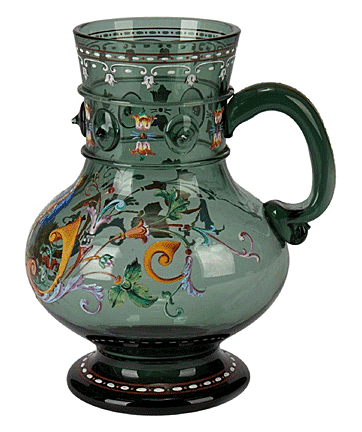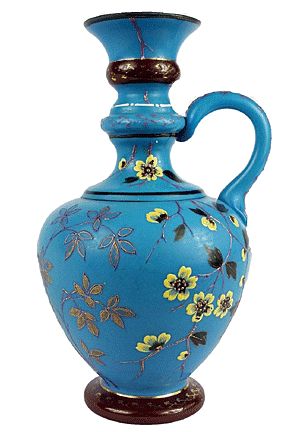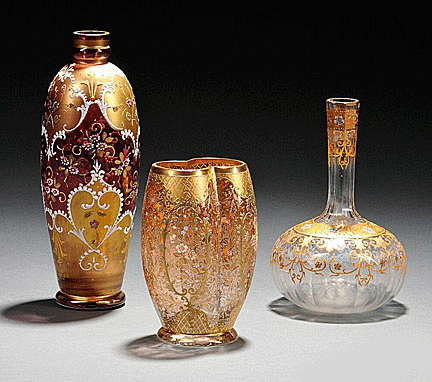|
Bejeweled Glass
by Bob Brooke
 Enameled
glass has existed in one form or another since ancient Egypt, 1400
years before the invention of glassblowing. But it wasn’t produced
in quantity until the days of the Roman Empire. After that, it
appeared in medieval Egypt and Syria and through trading with
Venetian merchants, Venice, from where it spread to the Holy Roman
Empire. After a decline of enameled glass from the 1750s, French
glassmakers in the late 19th century revived enameled glass in newer
styles. Enameled
glass has existed in one form or another since ancient Egypt, 1400
years before the invention of glassblowing. But it wasn’t produced
in quantity until the days of the Roman Empire. After that, it
appeared in medieval Egypt and Syria and through trading with
Venetian merchants, Venice, from where it spread to the Holy Roman
Empire. After a decline of enameled glass from the 1750s, French
glassmakers in the late 19th century revived enameled glass in newer
styles.
Enameled glass was glass which had been decorated with vitreous
enamel—powdered glass, usually mixed with a binder, then fired to
fuse the glasses. It produced brilliant and long-lasting colors and
could be translucent or opaque. Unlike most methods of decorating
glass, it allowed painting using several colors, and along with
glass engraving, had been the main technique used to create the full
range of images on glass.
 The
Romans used enamel to decorate glass vessels as early as the late
Republican and early Imperial periods. Artisans either painted
designs freehand or over the top of outlines. The
Romans used enamel to decorate glass vessels as early as the late
Republican and early Imperial periods. Artisans either painted
designs freehand or over the top of outlines.
Many pieces were either tall, clear drinking glasses painted with
scenes of sex from mythology or violent hunting or gladiators
fighting, and low bowls, dating to between 20 and 70 C.E., some of
colored glass, painted with birds and flowers.
Venetian glassmakers used enameling on glass from the late 13th
century, mostly to make beakers.
By the mid-15th century, Angelo Barovier's workshop was the most
important in Venice. His family had introduced the technique in the
past. Venetian glassmakers exported much of their glass to the Holy
Roman Empire.Notonly didhis competitors copy his enameling
technique, but so did those in Germany and Bohemia.
 By
the mid16th century, enameled glass ceased to be fashionable in
Italy, but the broadly Venetian style remained popular in Germany
and Bohemia until the mid-18th century, after which the remaining
production was of much lower quality. By
the mid16th century, enameled glass ceased to be fashionable in
Italy, but the broadly Venetian style remained popular in Germany
and Bohemia until the mid-18th century, after which the remaining
production was of much lower quality.
The schwarzlot style originated with the glassmaker Johann Schaper
of Nuremberg in Germany around 1650. He used using only black enamel
on clear or sometimes white milk glass. This was a relatively linear
style, with images often drawing on printmaking at the time. Schaper
himself was the best artist to use it, specializing in landscapes
and architectural subjects.
 In
the 19th century there was increasing technical quality in many
parts of Europe, initially with revivalist or over-elaborate
Victorian styles. In the later part of the century fresher and more
innovative designs, often anticipating Art Nouveau, were led by
French makers such as Daum and Émile Gallé. It was for the first
time possible to kiln-fire pieces, greatly simplifying the process
and making it more reliable, reducing the risk of having to reject
pieces and so allowing more investment in elaborate decorative work.
The Prague firm of Moser was a leading producer. In
the 19th century there was increasing technical quality in many
parts of Europe, initially with revivalist or over-elaborate
Victorian styles. In the later part of the century fresher and more
innovative designs, often anticipating Art Nouveau, were led by
French makers such as Daum and Émile Gallé. It was for the first
time possible to kiln-fire pieces, greatly simplifying the process
and making it more reliable, reducing the risk of having to reject
pieces and so allowing more investment in elaborate decorative work.
The Prague firm of Moser was a leading producer.
Victorian glassmakers produced relatively large vases or bowls for
display in either Arts and Crafts and Art Nouveau styles, which was
especially well suited to glass.
The Enameling on Glass Technique
 To
enamel glass, artisans mixed powdered glass, either already colored
or clear glass mixed with the pigments, with a binder such as gum
arabic, resulting in a thick liquid texture allowing it to be
painted with brushes. Generally, the desired colors only appeared
after the piece had been fired, adding to the artist's difficulties.
Artists applied the paint to the vessel, called a “blank,” which had
already been formed. Once painted, the enameled glass vessel had to
be fired at a temperature high enough to melt the powder, but low
enough that the vessel itself was only softened sufficiently to fuse
the enamel with the glass surface, but not enough to deform or melt
the original shape. During the firing, the binding and demarcating
substances burned away. To
enamel glass, artisans mixed powdered glass, either already colored
or clear glass mixed with the pigments, with a binder such as gum
arabic, resulting in a thick liquid texture allowing it to be
painted with brushes. Generally, the desired colors only appeared
after the piece had been fired, adding to the artist's difficulties.
Artists applied the paint to the vessel, called a “blank,” which had
already been formed. Once painted, the enameled glass vessel had to
be fired at a temperature high enough to melt the powder, but low
enough that the vessel itself was only softened sufficiently to fuse
the enamel with the glass surface, but not enough to deform or melt
the original shape. During the firing, the binding and demarcating
substances burned away.
 Originally,
glassworkers achieved the enamel firing by holding the vessel in a
glass furnace on a long iron rod called a pontil. But during the
19th century, they used enamels with a lower melting point, enabling
the second firing to be done in a kiln. Originally,
glassworkers achieved the enamel firing by holding the vessel in a
glass furnace on a long iron rod called a pontil. But during the
19th century, they used enamels with a lower melting point, enabling
the second firing to be done in a kiln.
The melted enamels left a layer of glass projecting very slightly
above the vessel’s surface. By this time, glassmakers often used
enameling in combination with gilding. Sometimes elements of the
"blank," such as handles, had to be added after the enamel paints,
during the second firing.
<
Back to More Antique Spotlights
Next Article >
|
